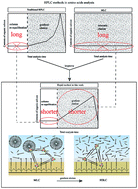Development of a gradient micellar liquid chromatographic method eluting from micellar mode to high submicellar mode for the rapid separation of free amino acids†
Abstract
A rapid surfactant-related gradient liquid chromatographic method progressing from a micellar liquid chromatographic mode to a submicellar liquid chromatographic mode has been developed for the quantitative analysis of free amino acids. It was applied successfully in the analysis of amino acids from a Compound Amino Acid Injection and the possible separation mechanism of gradient micellar chromatographic separations was discussed. Pre-column derivatization with 9-fluorenylmethyl chloroformate was used before chromatographic analysis. The mobile phase A was a sodium dodecyl sulfate solution containing 50 mM ammonium acetate at pH 3.5 and mobile phase B was 100% acetonitrile. The optimized chromatographic gradient elution conditions required an increase of mobile phase B from 25% (v/v) to 60% (v/v) in 30 min; the flow rate was 1.2 mL min−1; the stationary phase was a Venusil XBP column (5 μm, 250 × 4.6 mm); and the column temperature was set at 35 °C. The detected wavelength was set at 266 nm. The developed method was rapid; it offered both a short column re-equilibration time and short elution time.



 Please wait while we load your content...
Please wait while we load your content...